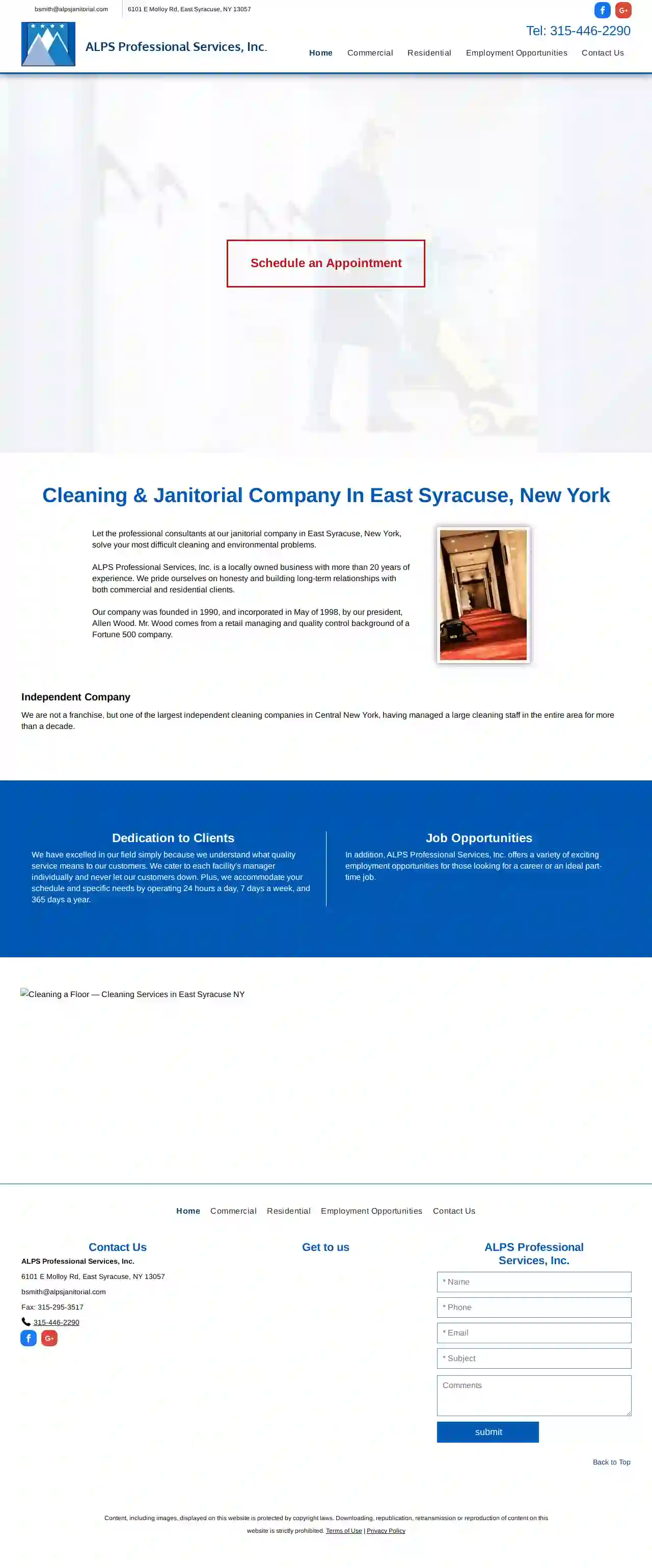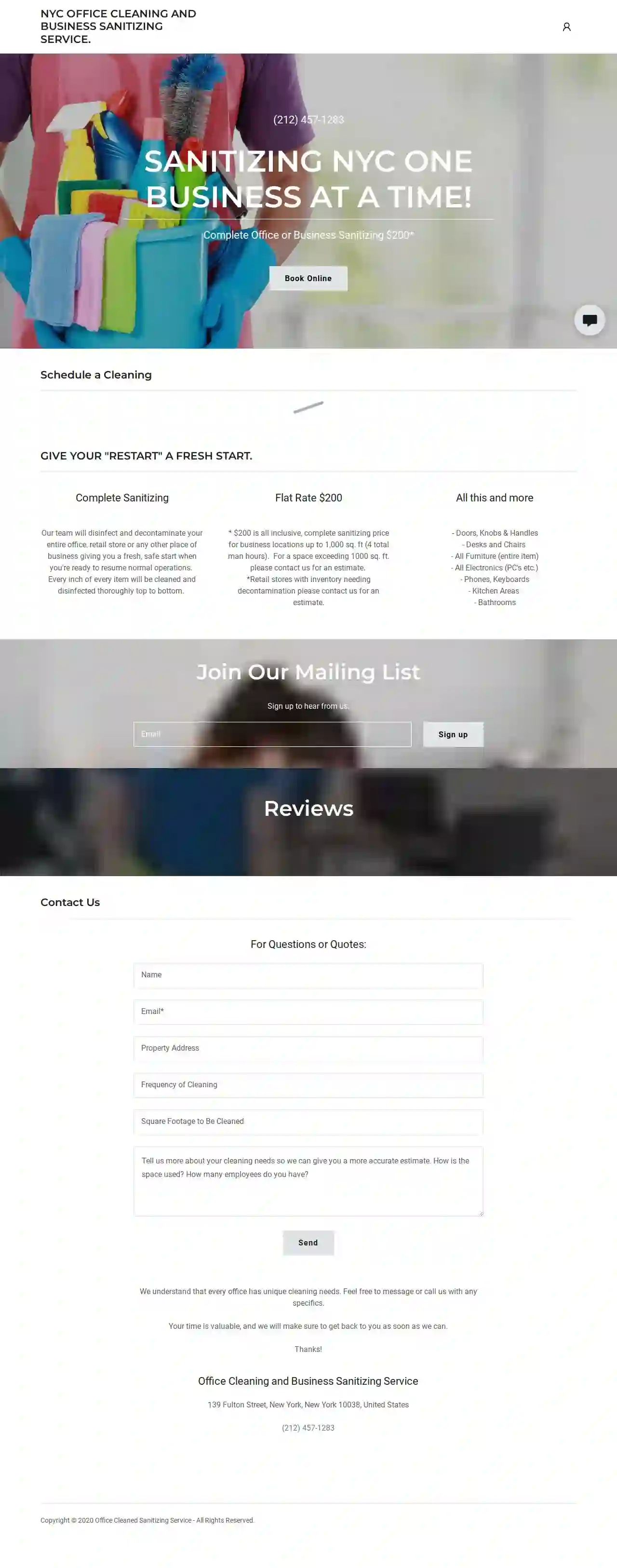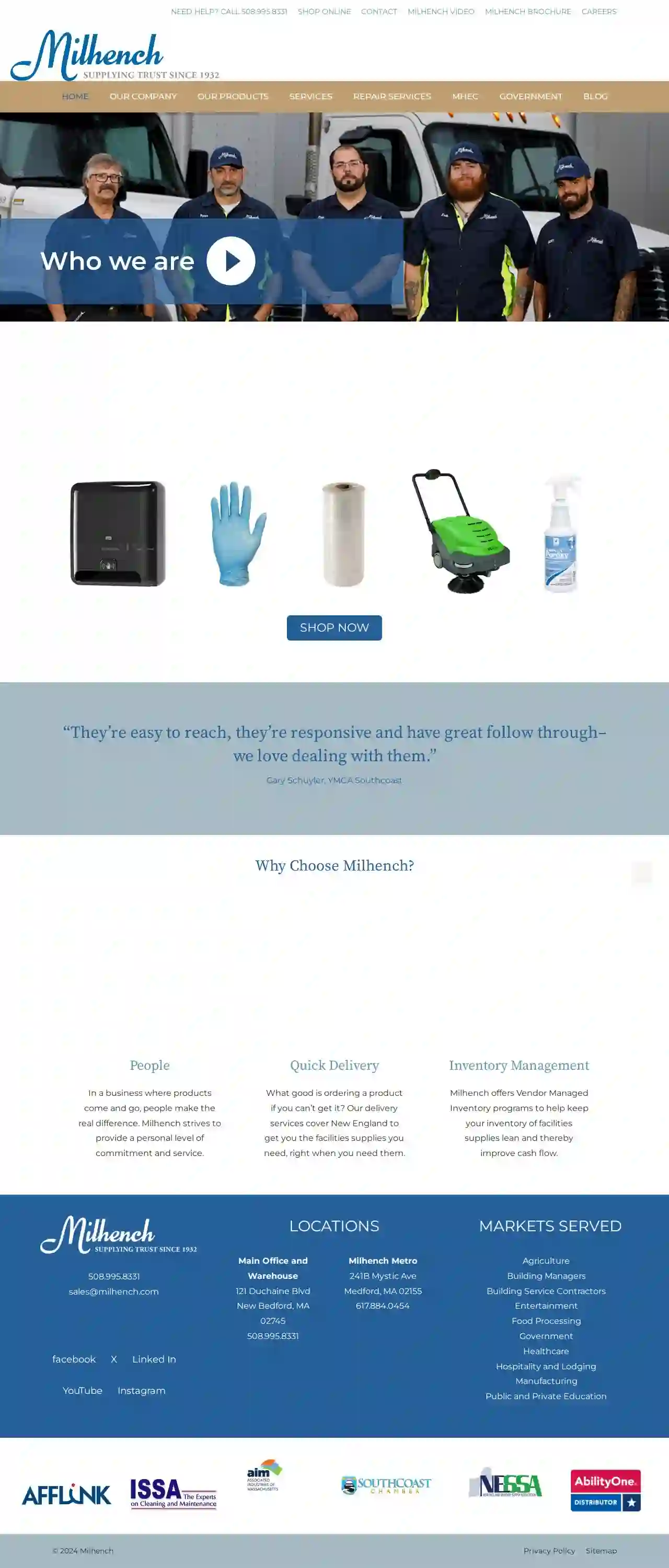Cleaning Services Monsey
Find Cleaning in Monsey
Get up to 3 Cleaning Companies quotes for your project today! Compare profiles, reviews, accreditations, portfolio, etc... and choose the best offer.

ALPS Professional Services, Inc.
3.45 reviewsSyracuse, US- Services
- Why Us?
- Gallery
Get Quote
Office Cleaned
52 reviewsNew York, 139 Fulton Street, 10038, USOffice Cleaning and Business Sanitizing Service offers comprehensive sanitizing solutions for offices, retail stores, and other business locations. Our team provides thorough disinfection and decontamination services, ensuring a fresh and safe start for your business. We cater to spaces up to 1,000 sq. ft. with a flat rate of $200, including cleaning and disinfecting of doors, knobs, handles, desks, chairs, furniture, electronics, phones, keyboards, kitchen areas, and bathrooms. For larger spaces or specific cleaning needs, we provide customized estimates. Our mission is to provide top-notch sanitizing services, ensuring your business is safe and clean for your employees and customers.
- Services
- Why Us?
- Accreditations
- Our Team
- Testimonials
Get Quote
Syracuse Cleaning Services
57 reviewsSyracuse, US- Services
- Why Us?
- Gallery
Get Quote
AG Organizing and Cleaning Services LLC
515 reviewsSyracuse, US- Services
- Why Us?
Get Quote
Lian Cleaning Services
525 reviewsSyracuse, US- Services
- Why Us?
- Gallery
Get Quote
Planet Maids
4.597 reviewsQueens, US- Services
- Why Us?
- Gallery
Get Quote
Gateway Cleaning Services
550 reviewsSuite 1, 9703 Gravois Rd, St. Louis, 63123, USGateway Cleaning Services offers premier cleaning services as part of the Titan Pest & Wildlife Solutions family, specializing in commercial and residential settings. We ensure that every space looks pristine and is conducive to a healthy, productive environment. Our mission is to provide peace of mind through superior cleaning services, enhanced by our integrated pest management and property maintenance approach, ensuring your spaces remain pristine and healthful. We prioritize our clients' needs, offering customized services tailored to their requirements. We use eco-friendly cleaning methods and products to ensure environmental safety and sustainability. We are reliable and consistent in our service delivery, ensuring our clients' peace of mind. We conduct our business with the utmost professionalism and ethical standards.
- Services
- Why Us?
- Accreditations
- Our Team
- Testimonials
- Gallery
Get Quote
Milhench Supply Co
4.36 reviews121 Duchaine Blvd, New Bedford, 02745, USMilhench is a family-run business that has been providing everyday necessities to keep businesses running cleanly and efficiently for over three generations. With a mission to deliver dependability, Milhench offers a personal level of commitment and service, quick delivery, and inventory management programs to help improve cash flow. They serve various markets including Agriculture, Building Managers, Building Service Contractors, Entertainment, Food Processing, Government, Healthcare, Hospitality and Lodging, Manufacturing, Public and Private Education.
- Services
- Why Us?
- Accreditations
- Our Team
- Testimonials
- Gallery
Get Quote
King Cleaning - Janitorial Service, Professional Deep Cleaning Services, Residential and Commercial Cleaning
54 reviewsQueens, US- Services
- Why Us?
Get Quote- Th
The Queen Dee of Cleaning LLC
4.948 reviewsQueens, US- Services
- Why Us?
Get Quote
Over 60,241+ Cleaning Companies on our platform
Our janitorial contractors operate in Monsey & beyond!
CleaningMatch has curated and vetted Top Cleaning Businesses near Monsey. Find a top & reliable business today.
Frequently Asked Questions About Cleaning Services
- Type of cleaning: Deep cleaning, regular cleaning, move-in/move-out cleaning, and specialized cleaning (e.g., carpet cleaning) have different price points.
- Size of the property: Larger properties typically require more time and resources, resulting in higher costs.
- Frequency of cleaning: Regular cleaning schedules often have discounted rates compared to one-time services.
- Location: Cleaning costs can differ based on regional labor costs and demand.
- Additional services: Extra tasks, such as window cleaning, laundry, or organization, will add to the overall price.
- Ventilation: Open windows and turn on the exhaust fan to improve air circulation.
- Declutter: Remove any items from countertops, the shower, and the floor to allow easy access.
- Pre-treat: Spray shower walls, tub, and toilet bowl with bathroom cleaner and let it sit for a few minutes to break down grime.
- Toilet: Scrub the toilet bowl with a toilet brush, paying attention to the rim and under the seat. Wipe down the exterior of the toilet with a disinfectant wipe.
- Shower/Tub: Scrub the shower walls and tub with a sponge or scrub brush. Rinse thoroughly.
- Sink: Clean the sink with a sponge or cloth and bathroom cleaner. Pay attention to the faucet and drain.
- Mirrors and Glass: Wipe down mirrors and glass surfaces with a glass cleaner and a microfiber cloth for a streak-free finish.
- Floors: Sweep or vacuum the floor, then mop with a floor cleaner designed for your bathroom floor type.
- Finishing Touches: Empty the trash can, replace towels, and put away any toiletries.
- Prepare the Windows: Remove dust and debris from windows using a brush, vacuum, or damp cloth.
- Cleaning Solution: Use a commercial glass cleaner or a homemade solution of equal parts water and vinegar.
- Spray and Wipe: Spray the cleaning solution onto the window, ensuring even coverage.
- Squeegee Technique: Use a squeegee to wipe the cleaner from top to bottom, overlapping each stroke by about an inch. Wipe the squeegee blade clean after each stroke.
- Dry Edges: Wipe the edges of the window with a clean, dry microfiber cloth to remove any remaining moisture.
- Ventilation: Improve ventilation by opening windows, turning on the exhaust fan, and using a dehumidifier to reduce moisture levels.
- Bleach Solution: Mix one cup of bleach with one gallon of water. Wear gloves and eye protection when handling bleach. Apply the solution to the affected area, let it sit for 10-15 minutes, then scrub with a brush and rinse thoroughly.
- Vinegar Solution: For a milder alternative, mix equal parts water and vinegar. Apply to the moldy area, let it sit for an hour, then scrub and rinse.
- Baking Soda Paste: Make a paste of baking soda and water, apply to the moldy area, let it dry, then scrub and rinse. Baking soda helps remove stains and deodorize.
- Commercial Mold and Mildew Remover: Use a commercial mold and mildew remover according to the product instructions.
How much do cleaning services cost in the USA?
To get accurate pricing, request personalized quotes from reputable cleaning services on CleaningMatch. They will assess your specific needs and provide a tailored cost estimate.
What is the best way to clean a bathroom?
By following these steps, you can maintain a clean and hygienic bathroom.
What is the best way to clean windows without streaks?
For best results, clean windows on a cloudy day or in the shade to prevent the cleaning solution from drying too quickly and leaving streaks.
How do I remove mold and mildew from my bathroom?
Always test any cleaning solution on a small, inconspicuous area first. After cleaning, take steps to prevent future mold growth by addressing moisture issues, such as fixing leaks and improving ventilation.
How much do cleaning services cost in the USA?
- Type of cleaning: Deep cleaning, regular cleaning, move-in/move-out cleaning, and specialized cleaning (e.g., carpet cleaning) have different price points.
- Size of the property: Larger properties typically require more time and resources, resulting in higher costs.
- Frequency of cleaning: Regular cleaning schedules often have discounted rates compared to one-time services.
- Location: Cleaning costs can differ based on regional labor costs and demand.
- Additional services: Extra tasks, such as window cleaning, laundry, or organization, will add to the overall price.
To get accurate pricing, request personalized quotes from reputable cleaning services on CleaningMatch. They will assess your specific needs and provide a tailored cost estimate.
What is the best way to clean a bathroom?
- Ventilation: Open windows and turn on the exhaust fan to improve air circulation.
- Declutter: Remove any items from countertops, the shower, and the floor to allow easy access.
- Pre-treat: Spray shower walls, tub, and toilet bowl with bathroom cleaner and let it sit for a few minutes to break down grime.
- Toilet: Scrub the toilet bowl with a toilet brush, paying attention to the rim and under the seat. Wipe down the exterior of the toilet with a disinfectant wipe.
- Shower/Tub: Scrub the shower walls and tub with a sponge or scrub brush. Rinse thoroughly.
- Sink: Clean the sink with a sponge or cloth and bathroom cleaner. Pay attention to the faucet and drain.
- Mirrors and Glass: Wipe down mirrors and glass surfaces with a glass cleaner and a microfiber cloth for a streak-free finish.
- Floors: Sweep or vacuum the floor, then mop with a floor cleaner designed for your bathroom floor type.
- Finishing Touches: Empty the trash can, replace towels, and put away any toiletries.
By following these steps, you can maintain a clean and hygienic bathroom.
What is the best way to clean windows without streaks?
- Prepare the Windows: Remove dust and debris from windows using a brush, vacuum, or damp cloth.
- Cleaning Solution: Use a commercial glass cleaner or a homemade solution of equal parts water and vinegar.
- Spray and Wipe: Spray the cleaning solution onto the window, ensuring even coverage.
- Squeegee Technique: Use a squeegee to wipe the cleaner from top to bottom, overlapping each stroke by about an inch. Wipe the squeegee blade clean after each stroke.
- Dry Edges: Wipe the edges of the window with a clean, dry microfiber cloth to remove any remaining moisture.
For best results, clean windows on a cloudy day or in the shade to prevent the cleaning solution from drying too quickly and leaving streaks.
How do I remove mold and mildew from my bathroom?
- Ventilation: Improve ventilation by opening windows, turning on the exhaust fan, and using a dehumidifier to reduce moisture levels.
- Bleach Solution: Mix one cup of bleach with one gallon of water. Wear gloves and eye protection when handling bleach. Apply the solution to the affected area, let it sit for 10-15 minutes, then scrub with a brush and rinse thoroughly.
- Vinegar Solution: For a milder alternative, mix equal parts water and vinegar. Apply to the moldy area, let it sit for an hour, then scrub and rinse.
- Baking Soda Paste: Make a paste of baking soda and water, apply to the moldy area, let it dry, then scrub and rinse. Baking soda helps remove stains and deodorize.
- Commercial Mold and Mildew Remover: Use a commercial mold and mildew remover according to the product instructions.
Always test any cleaning solution on a small, inconspicuous area first. After cleaning, take steps to prevent future mold growth by addressing moisture issues, such as fixing leaks and improving ventilation.